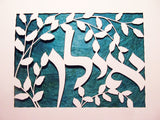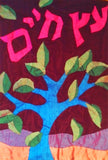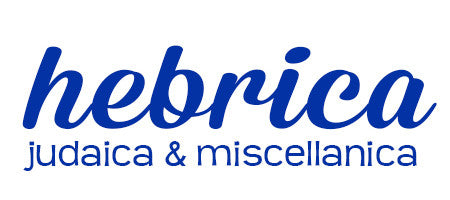 (Deut. 20:19-20) Seems like an odd bit of care-taking in the middle of a siege, but how lovely.The rule here is for fruit trees, and it's to everyone's benefit to preserve them. The papercut shown here is of the Hebrew name Ilon, which means "tree." The design is reminiscent of the Kermes oak, which grows in the place where Abraham was promised the Land.*
(Deut. 20:19-20) Seems like an odd bit of care-taking in the middle of a siege, but how lovely.The rule here is for fruit trees, and it's to everyone's benefit to preserve them. The papercut shown here is of the Hebrew name Ilon, which means "tree." The design is reminiscent of the Kermes oak, which grows in the place where Abraham was promised the Land.*
 Trees are so prominent in the Hebrew bible, from the Tree of Knowledge to the acacia wood used to build the tabernacle to the terebinths of Mamre to the words of the Psalmist: "The righteous shall flourish like the palm tree; he shall grow like a cedar in Lebanon." (Ps. 92:13) Trees areboth practical and symbolic. For a people that came together in the desert, trees must be the very embodiment of life, fertility, sustenance, shade, and delight. The Torah itself is described as "a tree of life, to those who cling to it." (Prov. 3:18)**
Trees are so prominent in the Hebrew bible, from the Tree of Knowledge to the acacia wood used to build the tabernacle to the terebinths of Mamre to the words of the Psalmist: "The righteous shall flourish like the palm tree; he shall grow like a cedar in Lebanon." (Ps. 92:13) Trees areboth practical and symbolic. For a people that came together in the desert, trees must be the very embodiment of life, fertility, sustenance, shade, and delight. The Torah itself is described as "a tree of life, to those who cling to it." (Prov. 3:18)**
Trees figure in Jewish mysticism, too. A favorite kabbalistic image is off an upside-down tree, its branches touching the earth, its roots in heaven, the source of all life. (We feel a papercut coming on.)
Here's a list of the trees mentioned in the Hebrew bible.
More on the amazing trees of Israel, here.
If you are inspired by trees in the bible, or in the land of Israel today, or any other subject, let me create a Jewish papercut for you; contact me here.
Plant a tree in Israel.
__
Kim Phillips is a Judaica artist in Nashville, Tennessee. Click here for bio.

Wow, great article.Really thank you! Keep writing. Lejman